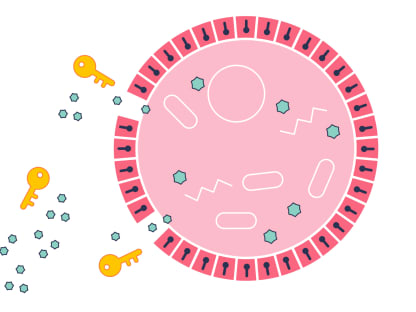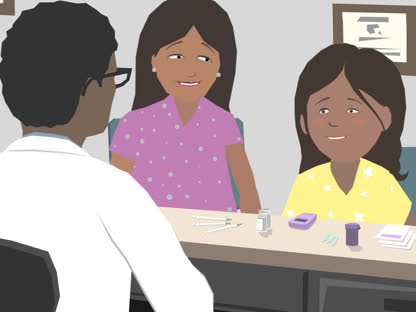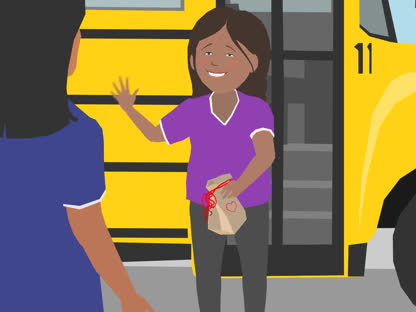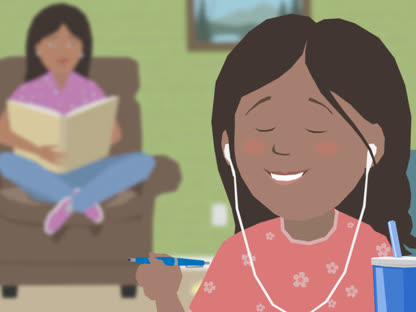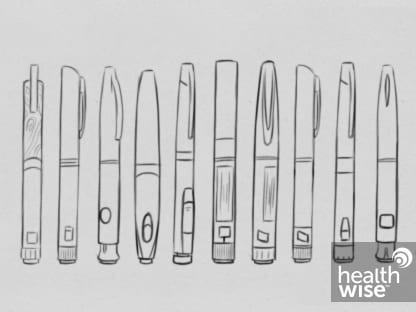Type 2 Diabetes in Children
Condition Basics
What is type 2 diabetes in children?
Type 2 diabetes is a condition in which a person has too much sugar (glucose) in their blood. Experts believe the disease develops in children the same way it does in adults. Insulin is a hormone that helps the body's cells use sugar for energy. Without insulin, the sugar can't get into the cells to do its work. It stays in the blood instead. This can cause high blood sugar levels.
Over time, high blood sugar can damage a child's eyes, heart, blood vessels, nerves, and kidneys. High blood sugar also makes a child more likely to get serious illnesses or infections.
In the past, doctors believed that type 2 diabetes was an adult disease and that type 1 diabetes was a children's disease. Now, more and more children are getting type 2 diabetes.
What are the symptoms?
Most children with type 2 diabetes don't have symptoms when the disease is first found. If a child has symptoms, they usually are mild. They may include having to urinate more often, feeling a little more thirsty than normal, and losing a little weight for no clear reason.
How is it diagnosed?
A simple blood test is usually all that is needed to diagnose diabetes. A doctor may do this test if your child has risk factors for diabetes, such as being overweight. Some children are diagnosed with type 2 diabetes when they have a blood or urine test for some other reason.
How is type 2 diabetes in children treated?
Treatment of type 2 diabetes in children focuses on keeping blood sugar levels within a target range. To reach this target range, your child needs to eat healthy meals with the right portion size and get some exercise each day. Treatment also may include medicine.
Related Videos
Health Tools help you make wise health decisions or take action to improve your health.
Experts don't know exactly what causes type 2 diabetes. But they do know some things that increase a child's risk. The main ones are:
- Being overweight.
- Getting little or no exercise.
- Having a parent, sister, or brother who has diabetes.
A child's risk is also higher if the child:
- Is African American, Hispanic, Native American, Asian American, or Pacific Islander.
- Was born to a mother who had gestational diabetes, Opens dialog.
- Was small for their gestational age, Opens dialog at birth.
Helping your child stay at a healthy weight, eat a healthy diet, and get regular exercise can help prevent type 2 diabetes. Some children may need to lose weight if they are overweight and have reached adult height. In some severe cases, weight loss may be needed before a child reaches full adult height.
Prediabetes, Opens dialog increases a child's risk for type 2 diabetes. If your child has prediabetes, eating a healthy diet and getting more exercise may return your child's blood sugar to a normal range, and it might prevent type 2 diabetes. Your child will still need to see a doctor regularly to check for signs of diabetes.
Learn more
Most children with type 2 diabetes don't have symptoms when the disease is first found. That's because their blood sugar level has been rising so slowly. As a result, a child may have diabetes for several months or years before being diagnosed.
If a child has symptoms, they usually are mild. The most common ones are:
- Having to urinate more often. The child may start wetting the bed at night.
- Feeling a little more thirsty than normal.
- Losing a little weight for no clear reason.
Other possible symptoms include:
- Increased tiredness.
- Nausea.
- Blurred vision.
- Frequent infections and slow-healing wounds or sores.
Learn more
Over time, type 2 diabetes can lead to serious problems such as:
- Eye disease (diabetic retinopathy).
- Diabetic kidney disease.
- High blood pressure or high cholesterol. These diseases increase the risk of heart and blood vessel disease later in life.
The longer a person has diabetes, the more likely these problems are. Children who have type 2 diabetes may have a higher risk of problems because they will have diabetes for a long time. Keeping their blood sugar in the target range every day may help to delay or prevent some of these problems.
Diabetes can also cause growth and development problems.
- If blood sugar levels stay high for a long time, a child may grow faster than normal for a while, then slower than normal.
- If a child is overweight and has high blood sugar levels for a long time, puberty and menstruation may start earlier. And periods may be irregular.
Learn more
Watch
Call 911 or other emergency services immediately if your child:
- Has symptoms of hyperosmolar state, Opens dialog, such as:
- Blurred vision.
- Trouble staying awake or trouble being woken up.
- Fast, deep breathing.
- Breath that smells fruity.
- Belly pain, not feeling hungry, and vomiting.
- Feeling confused.
Less common in type 2 diabetes is diabetic ketoacidosis (DKA), Opens dialog, which has symptoms similar to those of hyperosmolar state. But DKA is still possible and very dangerous.
- Has passed out (lost consciousness) or has suddenly become very sleepy or confused. (Your child may have very low blood sugar, called hypoglycemia, Opens dialog.)
Call a doctor now if your child:
- Is sick and has blood sugar that cannot be managed. Your doctor may have given you instructions on how to manage blood sugar when your child is sick.
- Has been vomiting or has had diarrhea for more than 6 hours.
- Has blood sugar that stays higher than the level the doctor has set for your child (for example, 240 mg/dL for two or more readings).
- Has blood sugar that stays lower than the level the doctor has set for your child (for example, 70 mg/dL for two or more readings).
- Has symptoms of low blood sugar, such as:
- Sweating.
- Feeling nervous, shaky, and weak.
- Extreme hunger and slight nausea.
- Dizziness and headache.
- Blurred vision.
- Confusion.
Check with your doctor if your child:
- Often has problems with high or low blood sugar levels.
- Has trouble knowing when their blood sugar is low (hypoglycemia unawareness, Opens dialog).
- Or you have questions or want to know more about diabetes.
Watchful waiting
Watchful waiting is a wait-and-see approach. It's not a good choice if:
- You think your child may have symptoms of type 2 diabetes. A simple blood test is all that is needed to find out if your child has the disease.
- Your child is overweight and gets little or no exercise. Your child is at risk for diabetes. Finding and treating type 2 diabetes early can prevent or delay complications from the disease.
- You have been told that your child has prediabetes. This condition can lead to type 2 diabetes. If your child eats a healthy diet and exercises regularly, your child may not develop diabetes.
Check your symptoms
A simple blood test is usually all that is needed to diagnose diabetes. A doctor may do a blood sugar (glucose) test if your child has any risk factors for diabetes, such as being overweight or getting little or no exercise. The doctor may repeat the test to confirm the diagnosis.
The doctor may do other blood tests if it's not clear whether your child has type 1 or type 2 diabetes.
Learn more
Treatment of type 2 diabetes in children focuses on keeping blood sugar levels within a target range. Treatment includes:
- Healthy eating.
Children who have diabetes need healthy meals that provide the right amount of calories and carbohydrates.
- Physical activity.
Being active helps the body use insulin correctly and helps control weight. Children need at least 1 hour of moderate to vigorous activity every day.
- Weight management.
A child who is overweight may need to lose weight (or stay at the same weight). This depends on age, development, and other risk factors.
- Home blood sugar monitoring.
Your child's blood sugar level may need to be checked regularly.
- Medicines.
Your child may take medicine to lower blood sugar. Some children need daily insulin. Some may also need medicine for high blood pressure or high cholesterol.
Learn more
Watch
Childhood and the teen years are a hard time to be diagnosed with diabetes. You play a major role in helping your child manage this disease. Try to set a good example. It will be easier for your child if the rest of the family also eats well and gets regular exercise.
- Teach your child to make healthy food choices.
- Help your child to eat about the same amount of carbohydrates at each meal. This helps keep your child's blood sugar steady. Carbohydrate affects blood sugar more than other nutrients. It is found in sugar and sweets, grains, fruit, starchy vegetables, and milk and yogurt.
- Your child's doctor, a diabetes educator, or a registered dietitian can help you make an eating plan that is good for your child and also good for your family.
- Encourage your child be more active.
Kids need at least 1 hour of moderate to vigorous activity every day. It's okay for a child to be active in smaller blocks of time that add up to 1 hour or more each day. Your child doesn't have to start a strict exercise program, but being more active can help control blood sugar.
- Help your child find ways to make activity more fun. For example, your child could play outside with friends, take brisk walks with a family member, and take part in sports.
- Limit the amount of time your child watches TV and uses the computer and cell phone.
- Check your child's blood sugar.
You and your child will need to monitor your child's blood sugar. This will help you learn how different foods and activities affect your child's blood sugar. Your doctor can teach you and your child how to do this.
- Help your child take medicine, if needed.
- A child with type 2 diabetes may need diabetes medicine to stay in the target blood sugar range. Your child may need one medicine at some times and more than one at other times.
- If your child has high blood pressure or high cholesterol, your child may need medicines for those conditions.
- Learn how to prepare and give insulin shots.
A child with type 1 diabetes may take several injections a day or use an insulin pump. A child with type 2 diabetes may need to take insulin for a while when first diagnosed or during illness or surgery. In time, a child may need daily insulin.
- Help your child become independent in caring for diabetes.
Let your child do as much of the care as possible. But provide support and guidance as needed.
- Children in grade school can help with all tasks required for their care. By age 8, children can test their own blood sugar if they are supervised.
- Children in middle school or junior high should be able to test their own blood sugar, but they may need help during low blood sugar episodes. By age 10, some children can give insulin shots if they are supervised.
- Teens should be able to handle their own care with some adult oversight.
Avoiding blood sugar emergencies
There are things you can do at home to help your child who has type 2 diabetes stay well and avoid the need for emergency treatment.
- Learn how to recognize and treat high and low blood sugar.
Even when you are careful and do all the right things, your child can have problems with high or low blood sugar. It's important to know what signs to look for and what to do if this happens.
- Have your child wear medical identification at all times.
In an emergency, a medical alert bracelet, Opens dialog, necklace, or a temporary tattoo lets people know that your child has diabetes so they can provide the right care.
- Know what to do if your child is ill.
Work with your doctor or diabetes educator to make a sick-day plan for your child. Discuss your child's target blood sugar goal during an illness. Know how to adjust the insulin dose and timing (if your child takes insulin) and when to contact your doctor for help.
- Work with your child's school and caregivers.
Make a plan to handle your child's special needs, such as knowing the symptoms of high or low blood sugar and how to treat them..
- Take care of your child's feet.
Diabetes can interfere with the body's ability to fight infection. So even a minor foot injury could lead to a serious infection.
- Be sure your child wears shoes that fit properly.
- Don't let your child go barefoot outdoors if there is a risk of getting a cut or any foot injury.
- Check your child's feet on a routine basis and anytime your child has a foot complaint. Look for signs of injury or infection. If you notice a foot problem, even a minor one, talk with your doctor before you treat it.
- Get support.
Some children and teens may have trouble keeping their blood sugar in a healthy range. Support groups can share encouragement and suggestions that may help you and your child deal with the daily issues of diabetes care. Ask your doctor about groups in your area.
Learn more
- Diabetes in Children: Checking Blood Sugar in a Child
- Diabetes: Counting Carbs
- Diabetes in Children: Food Issues at School
- Diabetes in Children: Preparing a Care Plan for School
- Diabetes in Children: Preventing High Blood Sugar
- Diabetes in Children: Special Camps
- Diabetes in Children: Treating Low Blood Sugar
- Sick-Day Guidelines for People With Diabetes
- Teens With Diabetes: Issues for Parents
Watch
Medicines that may be prescribed for children with type 2 diabetes are:
- Metformin.
This is the medicine of choice for children with type 2 diabetes. It is taken as a pill.
- Insulin.
Your doctor may suggest insulin if metformin doesn't keep your child's blood sugar in the target range. Insulin can be taken as a shot (injection) or through an insulin pump, Opens dialog.
- Some children need daily insulin. Even if your doctor doesn't prescribe daily insulin, your child may need to take it for a while when first diagnosed or during illness or surgery.
- Insulin may be given as a single nighttime dose, as several smaller doses throughout the day, or both.
Learn more
Watch
Current as of: April 30, 2024
Author: Ignite Healthwise, LLC Staff
Clinical Review Board
All Healthwise education is reviewed by a team that includes physicians, nurses, advanced practitioners, registered dieticians, and other healthcare professionals.
Current as of: April 30, 2024
Author: Ignite Healthwise, LLC Staff
Clinical Review Board
All Healthwise education is reviewed by a team that includes physicians, nurses, advanced practitioners, registered dieticians, and other healthcare professionals.
Topic Contents
This information does not replace the advice of a doctor. Ignite Healthwise, LLC, disclaims any warranty or liability for your use of this information. Your use of this information means that you agree to the Terms of Use. Learn how we develop our content.








